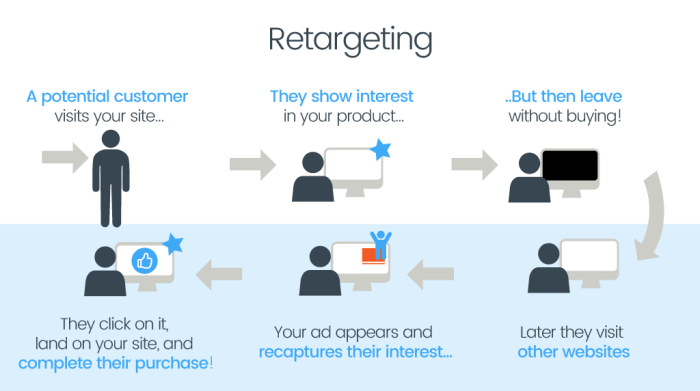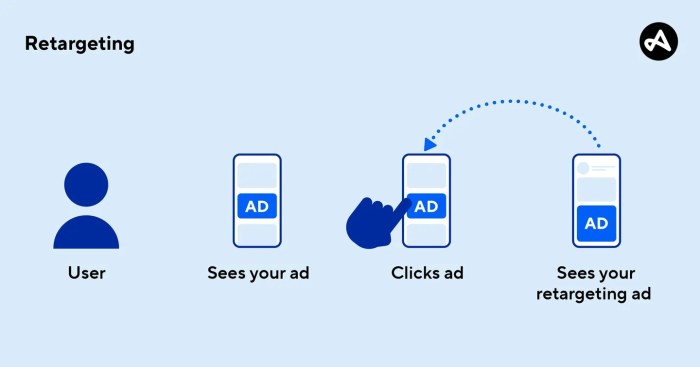Retargeting Ads Guide introduces you to the world of targeted advertising, providing insights into strategies and benefits that can revolutionize your marketing campaigns. Get ready to dive into a realm of possibilities and success stories that will elevate your advertising game to new heights.
What are Retargeting Ads?
Retargeting ads are a form of online advertising that targets users who have previously visited a website or interacted with a brand in some way. These ads are designed to remind potential customers of a product or service they showed interest in, encouraging them to return and complete a purchase.
How Retargeting Ads Work
Retargeting ads work by using cookies to track the online behavior of users. When a user visits a website, a cookie is placed on their browser, allowing the website to show targeted ads to that user as they browse the internet. This personalized approach helps businesses stay top-of-mind for potential customers and increase the likelihood of conversion.
- When a user visits a website but leaves without making a purchase, retargeting ads can display specific products or offers that the user viewed on the site.
- Retargeting ads can also be used to upsell or cross-sell products to users based on their previous interactions with a brand.
- Dynamic retargeting ads take personalization a step further by showing users ads featuring the exact products they viewed, creating a tailored shopping experience.
Examples of Retargeting Ad Strategies
Retargeting ads can take various forms depending on the goals of the business. Some common strategies include:
- Abandoned Cart Retargeting: Showing ads to users who added items to their cart but did not complete the purchase, reminding them to return and complete the transaction.
- Site Retargeting: Displaying ads to users who visited a specific page on a website, such as a product page or pricing information, to encourage them to revisit the site.
- Retargeting Lists: Segmenting users based on their behavior on a website and showing them targeted ads based on their specific interests or actions.
Benefits of Retargeting Ads
Retargeting ads offer several advantages for businesses looking to boost their marketing efforts and increase conversions. By targeting users who have already shown interest in your products or services, retargeting ads can help reinforce brand awareness and encourage potential customers to complete a purchase.
Increased Conversion Rates
Retargeting ads have been proven to significantly increase conversion rates compared to traditional display advertising. By targeting users who have already engaged with your brand, you are more likely to drive them back to your website and encourage them to make a purchase.
Improved ROI
Retargeting ads typically have a higher return on investment (ROI) compared to other advertising methods. Since you are targeting users who are already familiar with your brand, the cost per acquisition is often lower, resulting in a more cost-effective advertising strategy.
Enhanced Brand Awareness
Retargeting ads help keep your brand top of mind for potential customers. By displaying your ads to users who have already visited your website, you can reinforce brand awareness and increase the likelihood of them converting in the future.
Success Stories
Many companies have seen great success with retargeting ads. For example, XYZ Company saw a 30% increase in sales after implementing a retargeting campaign, while ABC Company reported a 50% increase in website traffic. These success stories demonstrate the effectiveness of retargeting ads in driving results for businesses of all sizes.
Types of Retargeting Ads

Retargeting ads come in various forms, each tailored to different stages of the customer journey and specific business goals. Let’s explore the different types of retargeting ads available:
1. Site Retargeting
Site retargeting involves displaying ads to users who have previously visited your website but did not complete a desired action, such as making a purchase or signing up for a newsletter. These ads are shown to remind visitors of your brand and bring them back to your site.
- Example: A user visits an online clothing store, looks at a few items, but leaves without making a purchase. Later, they see ads for the same clothing items they viewed on other websites.
2. Search Retargeting
Search retargeting targets users based on their search behavior on search engines. Ads are shown to users who have searched for specific s related to your business, even if they have not visited your website before. This type of retargeting allows you to reach potential customers based on their search intent.
- Example: A user searches for “best running shoes” on Google, and later sees ads for a sports store that sells running shoes, even though they did not visit the store’s website.
3. Social Media Retargeting
Social media retargeting involves showing ads to users who have engaged with your brand on social media platforms. These ads can be displayed on social media sites such as Facebook, Instagram, Twitter, or LinkedIn to re-engage users who have shown interest in your products or services.
- Example: A user follows a beauty brand on Instagram, likes several posts, but does not make a purchase. They later see ads from the brand showcasing new products on their Instagram feed.
4. Email Retargeting
Email retargeting targets users who have interacted with your email campaigns but have not taken the desired action. By displaying ads to these users across various online platforms, you can reinforce your message and encourage them to convert.
- Example: A user opens an email from a travel agency offering a discount on vacation packages but does not book a trip. They later see ads promoting the same discount on travel websites they visit.
Each type of retargeting ad serves a specific purpose and works best for different business goals. Understanding the nuances of each can help you create targeted campaigns that effectively re-engage potential customers and drive conversions.
Retargeting Ad Campaign Strategies: Retargeting Ads Guide

When it comes to creating successful retargeting ad campaigns, there are a few key steps to keep in mind. By segmenting your audiences effectively and optimizing your campaigns, you can improve results and drive more conversions.
Segmenting Audiences for Retargeting Ads, Retargeting Ads Guide
To segment your audiences for retargeting ads, consider factors such as website behavior, demographics, and previous interactions with your brand. By dividing your audience into smaller, targeted groups, you can create personalized ad campaigns that are more likely to resonate with each segment.
- Segment based on website behavior: Target users who have visited specific pages or taken certain actions on your website.
- Segment by demographics: Tailor your ads based on age, location, gender, or other demographic information.
- Segment by engagement level: Create separate campaigns for users who have interacted with your brand in different ways, such as signing up for emails or adding items to their cart.
By segmenting your audiences effectively, you can deliver more relevant ads that are likely to drive conversions.
Optimizing Retargeting Ad Campaigns
To optimize your retargeting ad campaigns for better results, consider the following tips:
- Use dynamic ads: Show users personalized content based on their past interactions with your website.
- Set frequency caps: Avoid bombarding users with too many ads by setting limits on how often they see your retargeting ads.
- Test different ad creatives: Experiment with different images, copy, and calls-to-action to see what resonates best with your audience.
- Track and analyze performance: Monitor key metrics such as click-through rates and conversion rates to make data-driven decisions about your campaigns.
By following these optimization tips, you can improve the effectiveness of your retargeting ad campaigns and drive better results for your business.












